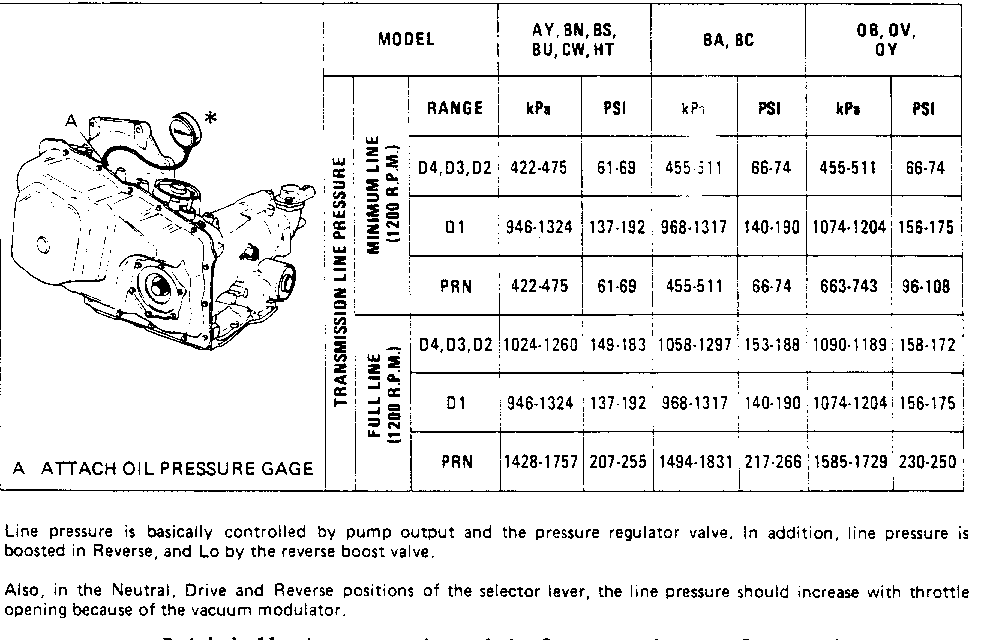NO/HARSH SHIFT ALL GEARS LOSS OF VACUUM

MODELS AFFECTED: 1985 FWD DEVILLE AND FLEETWOOD MODELS
This bulletin is intended to clarify the difference between vacuum modulator and Throttle Valve (TV) system related shift conditions on the THM 440-T4 transaxle used in 1985 FWD Deville and FWD Fleetwood vehicles. The THM 440-T4 transaxle has unique shifting controls, it uses a vacuum modulator for shift feel (harshness) and a TV system to determine shift timing (speed of shift).
Vacuum Modulator
Main line pressure boost on the THM 440-T4 transaxle (which affects shift feel or harshness) is controlled by the vacuum modulator to match the transaxle's line pressure to engine torque load. The vacuum modulator system may be suspect for harsh or slipping shift conditions on this transaxle.
For proper operation, the THM 440-T4 transaxle requires 44-57 kPa (13-17 in. Hg) of engine vacuum at hot engine idle checked at the modulator with the transaxle in DRIVE. An incorrect vacuum supply to the modulator may cause some or all of the listed conditions:
Harsh park to reverse engagement Harsh neutral to drive engagement Harsh or firm light throttle upshifts 2nd speed starts Harsh 3-2 coastdown shifts Rough 4-3 and 3-2 manual downshifts Slipping in drive or reverse Pressure regulator valve hydraulic buzz
An incorrect engine vacuum signal at the modulator can be caused by a pinched, cut, plugged or disconnected vacuum line. Additionally, engine mechanical as well as operating conditions related to the DFI, ignition, exhaust or emission systems may result in incorrect engine vacuum.
To check for proper vacuum, disconnect the vacuum supply line at the modulator and install a vacuum gage to the line. If there is less than 44-57 kPa (13-17 in. Hg) of vacuum at hot engine idle with the transaxle in DRIVE, locate the cause and correct as required. The gage reading may respond slowly to throttle movement because vacuum is supplied through an orifice in order to stabilize line pressure when shifting the transaxle between forward and reverse ranges.
If there is sufficient engine vacuum available to the modulator, remove the modulator assembly and modulator valve. Inspect the valve for nicks or scoring. Connect a hand operated vacuum pump to the modulator. Pump the device until 51-68 kPa (15-20 in. Hg) of vacuum is reached; at the same time, observe the modulator plunger, it should be drawn in as the vacuum pump is operated. After reaching 51-68 kPa (15-20 in. Hg), the vacuum should not bleed down for at least 30 seconds. Additional modulator checking procedures are outlined in the 1985 Service Information Manual (SIM), Section 7A, pages 7 and 8. Replace any modulator that fails one or more tests.
If the vacuum signal is within specification and the modulator is found to be functioning properly and the valve is not damaged, the shift problem is not vacuum related. At this time, an oil pressure check should be performed as outlined in the 440-T4 section of the 1985 SIM. Note the pressures and, if out of specification, refer to the appropriate diagnosis section in the Service Information Manual.
Throttle Valve (TV) System
The TV system used on the THM 440-T4 is unique in its operation. The TV cable in the THM 440-T4 is used exclusively for controlling shift points (shift speeds) and dent downshifts. Other TV cable equipped transmissions currently in use by Cadillac use the TV system to control shift points and detent downshifts as well as shift feel (harshness).
The TV system on the THM 440-T4 can be suspect for conditions of shift timing (shifts occurring at incorrect vehicle speeds). To determine if the TV cable is properly adjusted, refer to shift timing diagnosis in Section 7A of the 1985 FWD Service Information Manual.

General Motors bulletins are intended for use by professional technicians, not a "do-it-yourselfer". They are written to inform those technicians of conditions that may occur on some vehicles, or to provide information that could assist in the proper service of a vehicle. Properly trained technicians have the equipment, tools, safety instructions and know-how to do a job properly and safely. If a condition is described, do not assume that the bulletin applies to your vehicle, or that your vehicle will have that condition. See a General Motors dealer servicing your brand of General Motors vehicle for information on whether your vehicle may benefit from the information.
